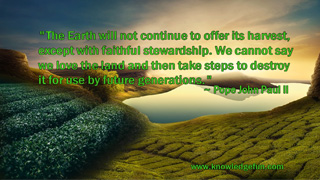An Extremely Crude Composting Process
by Steve Solomon
I've been evolving a personally-adapted composting system for the past twenty years. I've gone through a number of methods. I've used and then abandoned power chipper/shredders, used home-made bins and then switched to crude heaps; I've sheet composted, mulched, and used green manure. I first made compost on a half-acre lot where maintaining a tidy appearance was a reasonable concern. Now, living in the country, I don't have be concerned with what the neighbors think of my heaps because the nearest neighbor's house is 800 feet from my compost area and I live in the country because I don't much care to care what my neighbors think.
That's why I now compost so crudely. There are a lot of refinements I could use but don't bother with at this time. I still get fine compost. What follows should be understood as a description of my unique, personal method adapted to my temperament and the climate I live in. I start this book off with such a simple example because I want you to see how completely easy it can be to make perfectly usable compost. I intend this description for inspiration, not emulation.
I am a serious food gardener. Starting in spring I begin to accumulate large quantities of vegetation that demand handling. There are woody stumps and stalks of various members of the cabbage family that usually overwinter in western Oregon's mild winters. These biennials go into bloom by April and at that point I pull them from the garden with a fair amount of soil adhering to the roots. These rough materials form the bottom layer of a new pile.
Since the first principle of abundant living is to produce two or three times as much as you think you'll need, my overly-large garden yields dozens and dozens of such stumps and still more dozens of uneaten savoy cabbages, more dozens of three foot tall Brussels sprouts stalks and cart loads of enormous blooming kale plants. At the same time, from our insulated but unheated garage comes buckets and boxes of sprouting potatoes and cart loads of moldy uneaten winter squashes. There may be a few crates of last fall's withered apples as well. Sprouting potatoes, mildewed squash, and shriveled apples are spread atop the base of brassica stalks.
I grow my own vegetable seed whenever possible, particularly for biennials such as brassicas, beets and endive. During summer these generate large quantities of compostable straw after the seed is thrashed. Usually there is a big dry bean patch that also produces a lot of straw. There are vegetable trimmings, and large quantities of plant material when old spring-sown beds are finished and the soil is replanted for fall harvest. With the first frost in October there is a huge amount of garden clean up.
As each of these materials is acquired it is temporarily placed next to the heap awaiting the steady outpourings from our 2-1/2 gallon kitchen compost pail. Our household generates quite a bit of garbage, especially during high summer when we are canning or juicing our crops. But we have no flies or putrid garbage smells coming from the compost pile because as each bucketful is spread over the center of the pile the garbage is immediately covered by several inches of dried or wilted vegetation and a sprinkling of soil.
By October the heap has become about six feet high, sixteen feet long and about seven feet wide at the base. I've made no attempt to water this pile as it was built, so it is quite dry and has hardly decomposed at all. Soon those winter rains that the Maritime northwest is famous for arrive. From mid-October through mid-April it drizzles almost every day and rains fairly hard on occasion. Some 45 inches of water fall. But the pile is loosely stacked with lots of air spaces within and much of the vegetation started the winter in a dry, mature form with a pretty hard "bark" or skin that resists decomposition. Winter days average in the high 40s, so little rotting occurs.
Still, by next April most of the pile has become quite wet. Some garbagey parts of it have decomposed significantly, others not at all; most of it is still quite recognizable but much of the vegetation has a grayish coating of microorganisms or has begun to turn light brown. Now comes the only two really hard hours of compost-making effort each year. For a good part of one morning I turn the pile with a manure fork and shovel, constructing a new pile next to the old one.
First I peel off the barely-rotted outer four or five inches from the old pile; this makes the base of the new one. Untangling the long stringy grasses, seed stalks, and Brussels sprout stems from the rest can make me sweat and even curse, but fortunately I must stop occasionally to spray water where the material remains dry and catch my wind. Then, I rearrange the rest so half-decomposed brassica stumps and other big chunks are placed in the center where the pile will become the hottest and decomposition will proceed most rapidly. As I reform the material, here and there I lightly sprinkle a bit of soil shoveled up from around the original pile. When I've finished turning it, the new heap is about five feet high, six feet across at the bottom, and about eight feet long. The outside is then covered with a thin layer of crumbly, black soil scraped up where the pile had originally stood before I turned it.
Using hand tools for most kinds of garden work, like weeding, cultivating, tilling, and turning compost heaps is not as difficult or nearly as time consuming as most people think if one has the proper, sharp tools. Unfortunately, the knowledge of how to use hand tools has largely disappeared. No one has a farm-bred grandfather to show them how easy it is to use a sharp shovel or how impossibly hard it can be to drive a dull one into the soil.
Similarly, weeding with a sharp hoe is effortless and fast. But most new hoes are sold without even a proper bevel ground into the blade, much less with an edge that has been carefully honed. So after working with dull shovels and hoes, many home food growers mistakenly conclude that cultivation is not possible without using a rotary tiller for both tillage and weeding between rows. But instead of an expensive gasoline-powered machine all they really needed was a little knowledge and a two dollar file.
Similarly, turning compost can be an impossible, sweat-drenching, back-wrenching chore, or it can be relatively quick and easy. It is very difficult to drive even a very sharp shovel into a compost pile. One needs a hay fork, something most people call a "pitchfork." The best type for this task has a very long, delicate handle and four, foot long, sharp, thin tines. Forks with more than four times grab too much material. If the heap has not rotted very thoroughly and still contains a lot of long, stringy material, a five or six tine fork will grab too much and may require too much strength. Spading forks with four wide-flat blades don't work well for turning heaps, but en extremis I'd prefer one to a shovel.
Also, there are shovels and then, there are shovels. Most gardeners know the difference between a spade and a shovel. They would not try to pick up and toss material with a spade designed only to work straight down and loosen soil. However, did you know that there are design differences in the shape of blade and angle of handle in shovels. The normal "combination" shovel is made for builders to move piles of sand or small gravel. However, use a combination shovel to scrape up loose, fine compost that a fork won't hold and you'll quickly have a sore back from bending over so far. Worse, the combination shovel has a decidedly curved blade that won't scrape up very much with each stroke.
A better choice is a flat-bladed, square-front shovel designed to lift loose, fine-textured materials from hard surfaces. However, even well-sharpened, these tend to stick when they bump into any obstacle. Best is an "irrigator's shovel." This is a lightweight tool looking like an ordinary combination shovel but with a flatter, blunter rounded blade attached to the handle at a much sharper angle, allowing the user to stand straighter when working. Sharp irrigator's shovels are perfect for scooping up loosened soil and tossing it to one side, for making trenches or furrows in tilled earth and for scraping up the last bits of a compost heap being turned over.
Once turned, my long-weathered pile heats up rapidly. It is not as hot as piles can cook, but it does steam on chilly mornings for a few weeks. By mid-June things have cooled. The rains have also ceased and the heap is getting dry. It has also sagged considerably. Once more I turn the pile, watering it down with a fine mist as I do so. This turning is much easier as the woody brassica stalks are nearly gone. The chunks that remain as visible entities are again put into the new pile's center; most of the bigger and less-decomposed stuff comes from the outside of the old heap. Much of the material has become brown to black in color and its origins are not recognizable. The heap is now reduced to four feet high, five feet wide, and about six feet long. Again I cover it with a thin layer of soil and this time put a somewhat brittle, recycled sheet of clear plastic over it to hold in the moisture and increase the temperature. Again the pile briefly heats and then mellows through the summer.
In September the heap is finished enough to use. It is about thirty inches high and has been reduced to less than one-eighth of its starting volume eighteen months ago. What compost I don't spread during fall is protected with plastic from being leached by winter rainfall and will be used next spring. Elapsed time: 18-24 months from start to finish. Total effort: three turnings. Quality: very useful.
Obviously my method is acceptable to me because the pile is not easily visible to the residents or neighbors. It also suits a lazy person. It is a very slow system, okay for someone who is not in a hurry to use their compost. But few of my readers live on really rural properties; hopefully, most of them are not as lazy as I am.
At this point I could recommend alternative, improved methods for making compost much like cookbook recipes from which the reader could pick and choose. There could be a small backyard recipe, the fast recipe, the apartment recipe, the wintertime recipe, the making compost when you can't make a pile recipes. Instead, I prefer to compliment your intelligence and first explore the principles behind composting. I believe that an understanding of basics will enable you to function as a self-determined individual and adapt existing methods, solve problems if they arise, or create something personal and uniquely correct for your situation.





